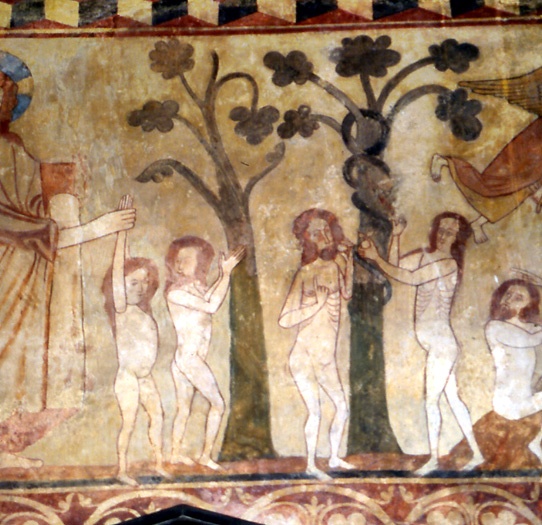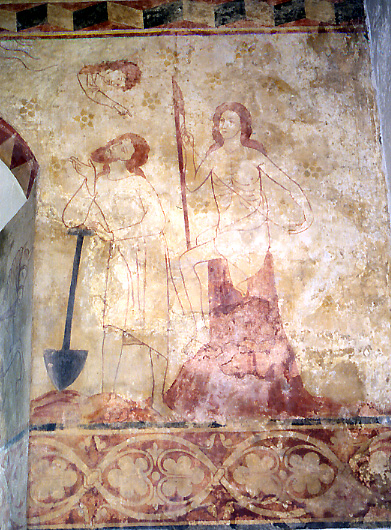Easby, N Yorkshire (†Ripon) C.13
Genesis Scenes
‘…and the woman said, The serpent beguiled me, and I did eat.’ [Genesis 3:13]

The paintings at Easby were last conserved in 1994 by the Perry Lithgow partnership, but there was a thoroughgoing ‘restoration’ before that in Victorian times, and, as so often with Victorian restorations, this would have amounted to a repainting. Fortunately, on the surviving evidence, this was not the disastrous travesty that the Victorians inflicted on some medieval paintings; the original medieval outlines of the figures seem to have been faithfully followed, and simpering picture-book sentimentality generally avoided.
At the left is the Creation of Eve, with God at the far left with his tripartite blue and gold halo, grasping Eve firmly by the wrists to haul her out of Adam’s side. Adam himself is not recumbent, but in a curious leaning posture (leaning on what it is impossible to say), but head propped on hand and obviously asleep. Beyond to the right God appears a second time, presenting Eve to Adam and holding in his draped left hand, an object that looks like a book. I think this is the Easby painter’s way of representing the Logos, the Greek term for the concept, thought and expression of the Word, which was there in the beginning, as in John 1:1. A great deal more than simply God the Father is meant by this, which is why the hand holding the book is veiled, even though it is God’s own.¹

Next to the right (and shown here at the right) comes the Temptation and Fall. The serpent is coiled around the tree in the standard manner. I can just make out its head and gaping mouth, with a bright red protruding tongue, but the detail is far from clear. Eve holds out the apple, complete with two leaves, to Adam.

Further right, in the usual continuous format, a worried-looking Adam sits on the ground, looking back towards Eve while an angel flies over his head. Eve is now shown sitting with Adam on the ground, pointing dramatically towards the tree, probably putting the blame on the serpent. Adam points upwards towards the angel, whose sword is now flaming (unfortunately the colour has gone from this detail). Both Adam and Eve are now on their feet, Eve wringing her hands, Adam extending his in pointless entreaty towards the implacable angel.

In the final scene, Adam and Eve are out in the world and afflicted with the Curse of Labour, represented here as usual by the delving and spinning of tradition. Adam, fully clothed and leaning on his blue spade, is evidently engaged in debate with another, apparently wingless, angel. Eve, sitting on a mound or rock, spins passively. Clearly, and as in the contemporary painting at Bledlow in Buckinghamshire, there is no going back.
The four surviving paintings of the Labours of the Months at Easby have been on the site for some time, and others, starting with the Life of the Virgin/Infancy of Christ sequence, will be here soon.
Website for St Agatha’s, Easby
¹ This is highly complex theology, and medieval theology at that, but the Easby painter could have called on the Premonstratensian canons of the adjacent St Agatha’s Abbey to advise him, and no doubt they did. Interestingly, the only other veiled hands I have come across in medieval wall painting are also in North Yorkshire, at Wensley. No longer true. St Paul holds a book in his veiled hand at Old Idsworth.
† in page heading = Diocese